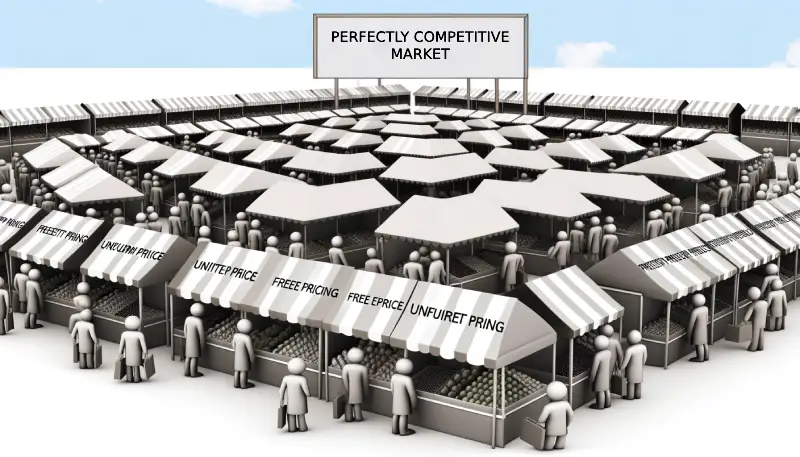A perfectly competitive market, also known as a competitive market, is an economic model where several conditions are met to ensure that no individual buyer or seller has any market power to influence prices. Here’s a detailed explanation of the key characteristics and dynamics of a perfectly competitive market:
### Characteristics of a Perfectly Competitive Market
1. **Large Number of Buyers and Sellers**: The market consists of a large number of buyers and sellers, so no single buyer or seller can influence the market price. Each participant is a price taker.
2. **Homogeneous Products**: The goods offered by different sellers are identical or perfectly substitutable. This means that consumers have no preference for products from one seller over another based on the product itself.
3. **Free Entry and Exit**: Firms can freely enter or exit the market without significant barriers. This ensures that profits are normalized in the long run as new firms enter when there are profits and exit when there are losses.
4. **Perfect Information**: All buyers and sellers have full and instantaneous knowledge about prices and product quality. This ensures that everyone makes well-informed decisions and that resources are allocated efficiently.
5. **No Transaction Costs**: There are no costs associated with making transactions, meaning buyers and sellers can trade without incurring additional expenses.
6. **Price Takers**: Both buyers and sellers accept the market price as given. Since each seller’s output is a small fraction of the total market, individual firms cannot influence the price.
### Dynamics of a Perfectly Competitive Market
1. **Price Determination**: The market price is determined by the intersection of the overall supply and demand curves. Individual firms accept this price as given and adjust their output accordingly.
2. **Profit Maximization**: Firms maximize their profits by producing the quantity of output where marginal cost (MC) equals marginal revenue (MR). In a perfectly competitive market, the marginal revenue is equal to the market price (P), so firms produce where MC = P.
3. **Zero Economic Profit in the Long Run**: In the long run, firms in a perfectly competitive market will earn zero economic profit. If firms are earning economic profit, new firms will enter the market, increasing supply and driving down the price until economic profits are eliminated. Conversely, if firms are incurring losses, some will exit the market, reducing supply and driving up the price until losses are eliminated.
4. **Efficient Allocation of Resources**: Perfect competition leads to allocative and productive efficiency. Allocative efficiency occurs because goods are produced up to the point where the last unit provides a marginal benefit to consumers equal to the marginal cost of producing it. Productive efficiency occurs because firms produce at the lowest possible cost in the long run.
### Real-World Application
In reality, perfectly competitive markets are rare, as the stringent conditions are difficult to meet. However, some markets, like agricultural products (e.g., wheat, corn) and certain financial markets, approximate perfect competition closely. The concept serves as a useful benchmark to compare with other market structures like monopolies, oligopolies, and monopolistic competition, helping economists understand the implications of different market conditions.
### Conclusion
The perfectly competitive market is an idealized framework that helps economists understand how markets operate under certain conditions. While no market perfectly meets all the criteria, the model provides insights into the benefits of competition, such as efficient resource allocation and the elimination of economic profits in the long run.

